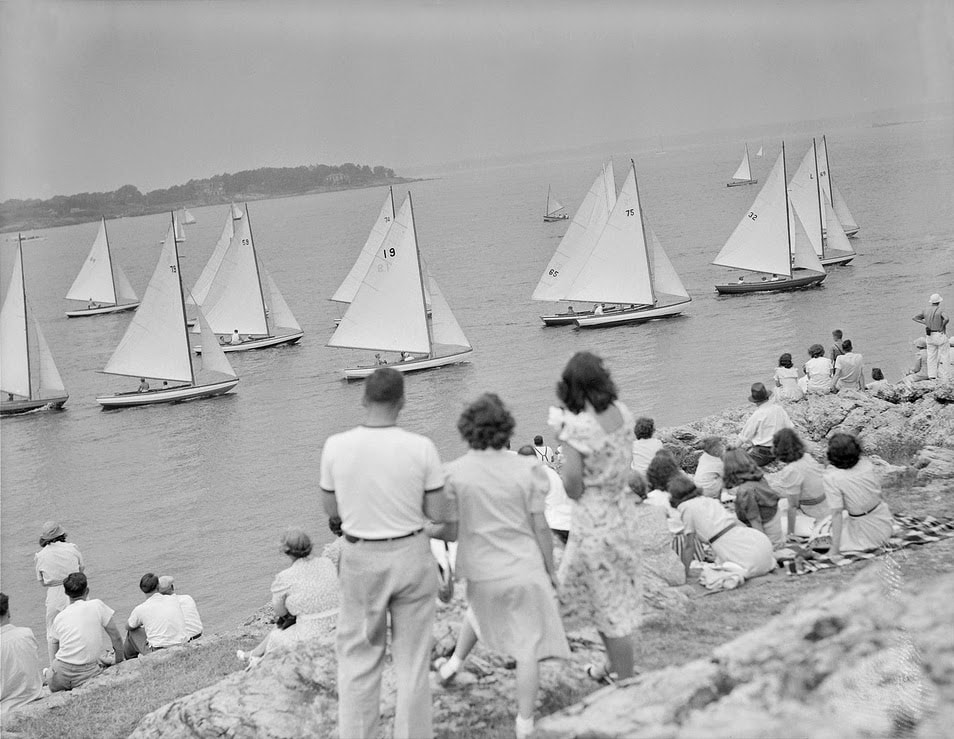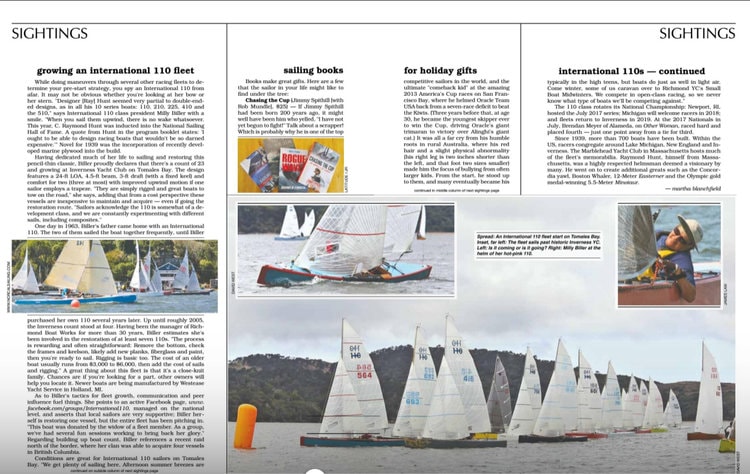International 110 boat Appeared in Latitude 38 December issue.
While doing maneuvers through several other fleets to determine your pre-start strategy, you spy an International 110 boat from afar. It may not be obvious whether you’ve looking at her stern or aft. International 110 class president Milly Biller smiles, “The visionary Hunt seemed very partial to double-ended designs, as in all his 10 series boats: 110, 210, 225, 410 and the 510. When you sail them upwind, there is no wake whatsoever.
This year, C. Raymond Hunt was inducted into the Sailing Hall of Fame. A quote from him in the program booklet states: ‘I ought to be able to design racing boats that wouldn’t be so darned expensive.’” Also of interest, and novel for 1939, was incorporation of recently developed marine plywood into the build.
Having dedicated much of her life to sailing and restoring this pencil-thin classic, Biller proudly states there to be a count of 23 and growing at her Inverness, California, port. The International 110 design features a 24-foot LOA, 4.5-foot beam, three-foot draft and comfort for two (three at most) with improved head-to-wind motion if one sailor employs a trapeze rig.
They are simply rigged and great boats to tow on the road,” she shares, adding that from a cost perspective this vessel is inexpensive to maintain and acquire—even if going the restoration route. “Sailors acknowledge the 110 is somewhat of a development class, and we are constantly experimenting with different sails, including composites.”
International 110 Boat Love
One day in 1963, Biller’s father came home with an International 110 boat. She and he sailed the boat together frequently, until Biller purchased her own 110 several years later. Up until roughly 2005, the Inverness count stood at four. Having been the manager of the Richmond Boatworks for more than 30 years, she estimates she’s been involved in the restoration of at least seven International 110s. The process is rewarding and often straightforward—remove the bottom, check the frames and keelson, likely add new planks, fiberglass and paint, then you’re ready to sail. Rigging is basic too. The cost of an older boat usually runs from $3,000 to $6,000, then add cost of sails and rigging.” A great thing about this fleet is that it’s a close-knit family. Chances are if you’re looking for a part, other owners will pitch in and help you locate. Newer boats are being manufactured by Westease Yacht Service in Holland, Michigan. As to her tactics for fleet growth, communication and peer influence fuel things. She points to an active International 110 Facebook (social media) page managed on the national level, and asserts that local sailors are very supportive; Biller herself is restoring one vessel, but the entire fleet has been pitching in. “This boat was donated by the widow of a fleet member. As a group, we’ve had several fun sessions working to bring back her glory.” Regarding building up boat count, Biller references a recent north of the border raid where her clan was able to acquire four vessels in British Columbia.Tri-state for the Duo-tip
Biller states that conditions are great for International 110 boat Inverness sailors. “We get plenty of sailing here. Afternoon summer breezes are typically in the high teens, but boats do just as well in light air. Come winter, some of us caravan over to the Richmond Yacht Club’s small boat midwinters. We compete in open class racing, so we never know what type of boat we’ll be competing against.” The 110 class rotates its nationals: Newport, RI, hosted the July 2017 series, Michigan is slated to welcome racers in 2018, and fleets return to Inverness in 2019. In July, East Coast favorite Joe Berkeley on retrad took the cup. Alameda, California, Brendan Meyer, on Other Woman, raced hard and placed fourth—just one point away from a tie for third. Since 1939, more than 700 of this pencil boat have been built. Northern California is not the only hub for International 110 lovers. Within the U.S., racers dominate around Lake Michigan, New England and Inverness. In fact, it’s the Marblehead Yacht Club (MA) that hosts much of the fleet’s memorabilia. The International 110 designer, C. Raymond Hunt of Massachusetts was a highly respected helmsman deemed visionary by many. He went on to create additional greats such as the Concordia yawl, Boston Whaler, 12 meter Easterner and the Olympic Gold Medal winning 5.5 meter Minotaur. https://www.facebook.com/groups/International110/ The International 110 was introduced at the 1939 Marblehead Race Week Regatta. Ray Hunt raced the boat around the coarse beating everyone boat for boat except the International One Design. With a price of $480.50 with sails the demand for this vessel began in earnest.
